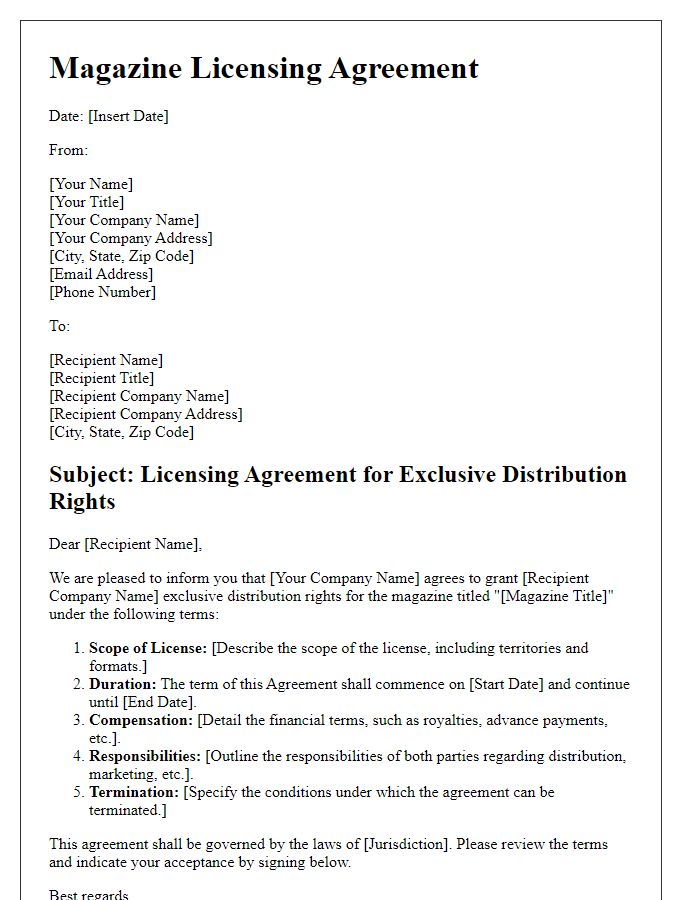Are you considering entering into a licensing agreement for your magazine? Crafting the right letter is crucial to ensure clarity and mutual understanding between all parties involved. In this article, we'll guide you through the essential components of a licensing agreement letter that protects your interests while fostering a positive relationship with your licensee. Keep reading to discover key tips and templates that can help streamline your process!

Parties Involved
The parties involved in the magazine licensing agreement include the Licensor (the publisher or owner of the magazine) and the Licensee (the individual or entity seeking to obtain the rights to use the magazine's content). The Licensor retains all copyrights and intellectual property rights associated with the magazine, ensuring control over its distribution and reproduction. The Licensee agrees to adhere to the terms of the agreement, which typically outline the scope of use, duration of the license, and any financial arrangements, such as royalties or licensing fees. Additionally, licensing agreements may specify geographic limitations, media formats, and any obligations related to the promotion and brand representation of the magazine. Both parties must carefully review the agreement to secure mutual interests and obligations adequately.
Grant of License
A licensing agreement grants permission for specified rights pertaining to intellectual property, essential for both licensing parties. This document outlines the scope of usage permitted under the license, including publication rights, duration of agreement, and territorial limitations. Typically, the agreement specifies the licensed material, often including photographs, articles, or artwork (for instance, a renowned article from the New York Times or a graphic by a celebrated illustrator). Key details, such as payment terms, royalties, and responsibilities for both parties, are crucial for ensuring smooth operations. The agreement may also address rights to modifications, sub-licensing, and termination conditions, including a provision for disputes resolution, ensuring both parties maintain clarity and legal protection throughout the term of the agreement.
Scope of Use
The licensing agreement for magazine content encompasses a diverse range of uses, including reproduction (the action of copying materials) in print formats, digital distribution (the electronic dissemination of content) through websites and social media platforms, and inclusion in promotional materials (advertisements, brochures, or other marketing collaterals). The agreement specifies the duration (a defined period, often one year) of the licensing rights, ensuring that the licensed materials (articles, images, illustrations) will be used in accordance with the established terms. Additionally, all adaptations (modifications or alterations to the original content), whether for editorial (related to the organization of content) or commercial purposes, require prior authorization from the original rights holder (the individual or organization owning the copyright), ensuring compliance with legal standards within the publishing industry.
Payment Terms
Payment terms outline the financial obligations agreed upon by the parties involved in a licensing agreement for magazine content. Payments may include an upfront licensing fee (typically ranging from $500 to $10,000, depending on the content's reach and exclusivity) and ongoing royalties (often 5% to 15% of net revenue generated from the licensed content). Payment schedules may be structured into quarterly or annual installments, with specific deadlines set for each payment (e.g., due within 30 days of receipt of invoice). Additionally, late payments may incur penalties (such as a 1.5% monthly interest charge) to encourage timely transactions. All financial transactions will be conducted in U.S. dollars, ensuring clarity and avoiding currency conversion issues.
Copyright and Intellectual Property Rights
Copyright and intellectual property rights protect original works, including written articles, images, and graphics, in publications. Through licensing agreements, magazines grant permission to use specific copyrighted material under defined conditions. Key components include the scope of use, duration (often ranging from one year to several years), and territorial rights (specifying geographical areas where the work can be used). Consideration for licensing fees or royalties might be agreed upon, accounting for potential circulation numbers and audience reach. It's crucial for both parties to define credit attribution requirements, ensuring creators receive acknowledgment for their contributions. Additionally, addressing repercussions for any breach of the agreement helps safeguard against unauthorized usage.
Letter Template For Magazine Licensing Agreement. Samples
Letter template of magazine licensing agreement for exclusive distribution rights.

Letter template of magazine licensing agreement for digital publication.

Letter template of magazine licensing agreement for international distribution.

Letter template of magazine licensing agreement for co-publishing arrangements.

Letter template of magazine licensing agreement for content syndication.

Letter template of magazine licensing agreement for promotional partnerships.

Letter template of magazine licensing agreement for print and digital formats.

Letter template of magazine licensing agreement for special edition releases.

Letter template of magazine licensing agreement for merchandise licensing.





Comments